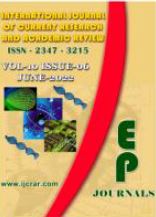Abstract Volume:10 Issue-6 Year-2022 Original Research Articles
 |
Online ISSN : 2347 - 3215 Issues : 12 per year Publisher : Excellent Publishers Email : editorijcret@gmail.com |
Nanotechnology is an emerging field of science with increased applications in diverse area for the development of new materials at nanoscale levels. Synthesis of nanoparticles using biological methods is referred as greener synthesis of nanoparticles. Pulses exudates of two different legumes; Mung bean (Vigna radiata), Cowpea (Vigna unguiculata)were used for the synthesis of silver, copper, and zinc nanoparticles anddetermine the antibacterial properties of these nanoparticles against Escherichia coli (E. coli), Pseudomonas aeruginosa, Staphylococcus aureus, Salmonella typhi and Klebsiella pneumoniae. Nanoparticles prepared from these seed extracts have antibacterial activity. Synthesized nanoparticles were characterized by UV-VIS Spectrophotometry. Silver nanoparticles shows maximum peak at 385 nm. Copper nanoparticles shows maximum peak at 680 nm. Zinc nanoparticles shows maximum peak at 350 nm. Synthesized silver, copper and zinc nanoparticles shows antibacterial activity against the selected bacterial species. Antimicrobial assay was performed by agar well diffusion method using Muller Hinton agar media. When antibacterial activity of silver, copper and zinc nanoparticles from 3 different concentrations were observed, nanoparticles have 150 µl concentration shows maximum activity against these microbes. Silver, Copper and Zinc nanoparticles showed greater antibacterial activity compared to silver nitrate, copper sulphate and zinc sulphate solution. This green synthesis method is alternative to chemical method, since it is cheap, pollutant free and eco-friendly.
How to cite this article:
Prem Jose Vazhacharickal and Gopika S. Krishna. 2022. Green Synthesis of Silver, Copper and Zinc Nanoparticles from Mung bean (Vigna radiata) and Cowpea (Vigna unguiculata) Exudates and Evaluation of their Antibacterial Activity: An Overview.Int.J.Curr.Res.Aca.Rev. 10(6): 48-81doi: https://doi.org/10.20546/ijcrar.2022.1006.006



Quick Navigation
- Print Article
- Full Text PDF
- How to Cite this Article
- on Google
- on Google Scholor
- Citation Alert By Google Scholar
